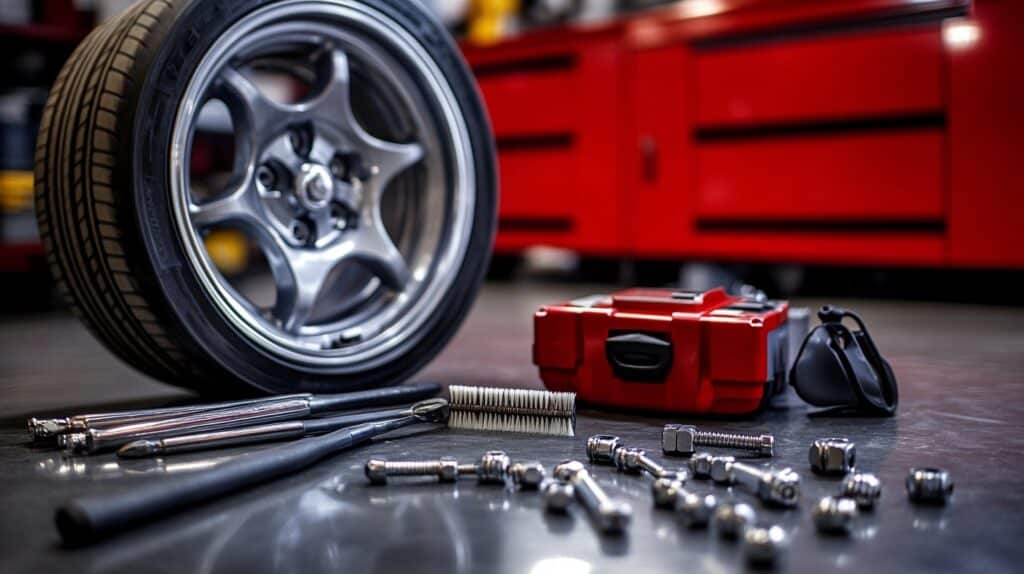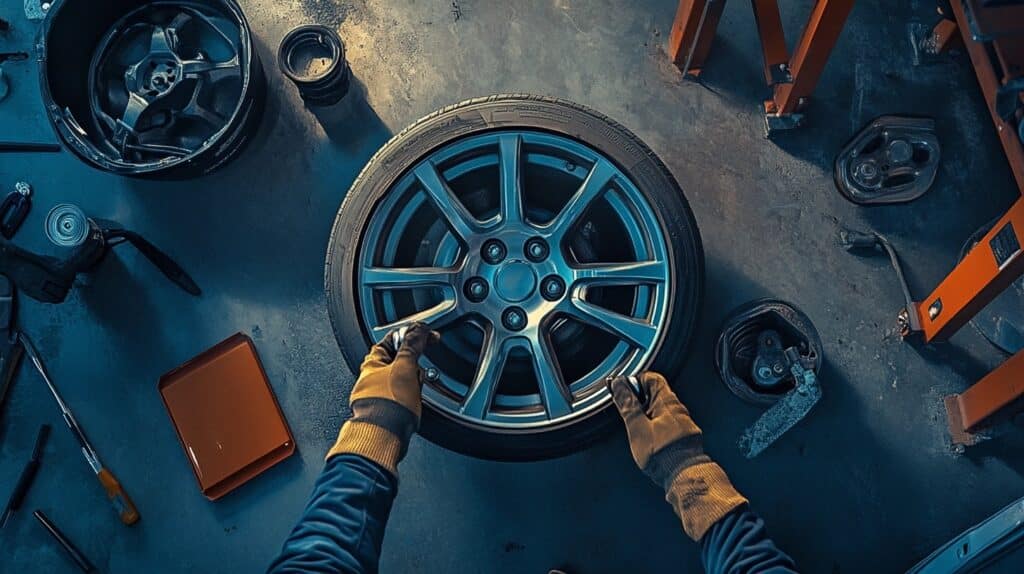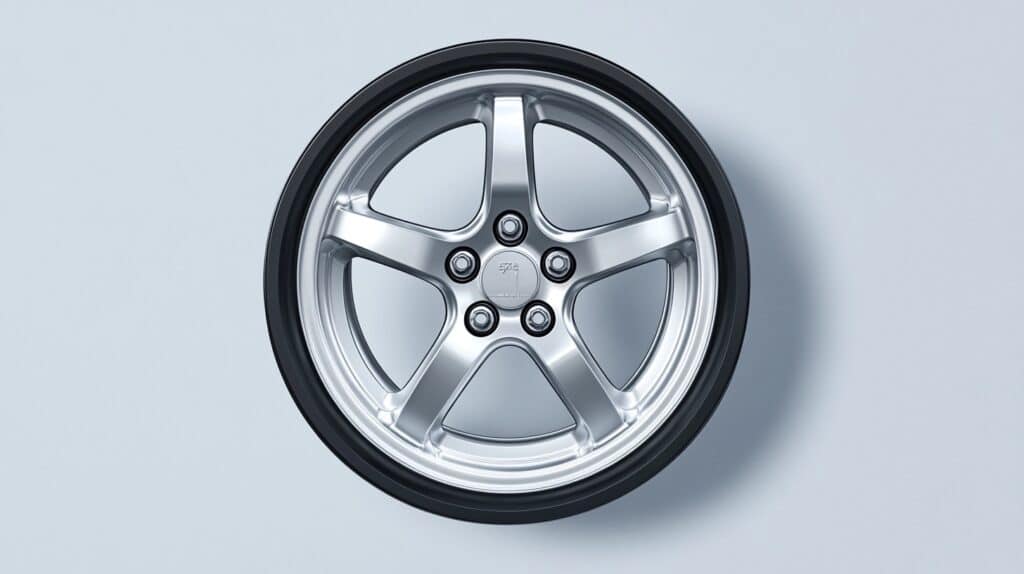Think of a wheel bolt pattern as your car’s handshake with its wheels – it needs to be just right.
The 5×4.75 bolt pattern has been a trusted standard for decades, especially in American classics and muscle cars. From vintage Chevrolets to modern Corvettes, this specific setup has stood the test of time.
Maybe you’re restoring a classic ride, swapping wheels, or just trying to understand what those numbers mean.
Whatever brought you here, we’ve got you covered. In this guide, we’ll walk through what the 5×4.75 measurement really means, which cars use this pattern, what you need to know before buying wheels, and common issues and solutions.
With 40+ years of combined experience working on classic cars, our team knows these patterns inside and out. Let’s help you make sense of it all.
Understanding 5×4.75 Bolt Pattern & Its Measurements
Let’s break down what these numbers actually mean in plain English. When you see “5×4.75” on a wheel spec sheet, you’re looking at two key measurements that work together.
The number “5” tells you how many lug holes are on the wheel. Take a look at any wheel with this pattern, and you’ll count exactly five bolts spaced evenly around the center.
The “4.75” part shows the size of the invisible circle these bolts make. Imagine drawing a circle through the center of all five lug holes – that circle would be 4.75 inches across. For those who work with metric measurements, this equals 120.7 millimeters.
How to Measure It Yourself
Want to check your bolt pattern at home? Here’s a simple way: measure from the center of one lug hole to the center of the hole directly across from it. Since there are five lugs (an odd number), you’ll measure to the back of the opposite hole.
What Are the Factors to Consider when Selecting Wheels with A 5x 4.75 Bolt Pattern

Finding the right wheels isn’t just about matching numbers. Here’s what you need to know before making a choice.
1. Hub and Stud Size Matter
Your wheel needs to fit perfectly over your car’s hub. Think of it like a glove – too loose or too tight won’t work. Check both your hub’s center bore size and stud size.
Your wheel’s center hole must match or be slightly larger than your hub (you can use hub rings to make up small differences).
2. Choosing Your Material
Steel wheels are like the trusty workhorses of the wheel world. They’re tough, cheaper to fix, and perfect for daily drivers.
Aluminum wheels, on the other hand, are lighter and often look fancier. But they can cost more and might need extra care.
3. Style Choices
Your car’s era should guide your wheel choice. Classic cars often look best with period-correct styles – think simple designs and clean lines.
Modern vehicles can handle more current looks with complex spoke patterns. But remember: the best-looking wheel is one that fits your car’s personality.
4. Weight and Performance
Heavier wheels can change how your car drives. A lighter wheel helps your car move and stop more easily.
But don’t go too light – your wheels still need to handle your car’s weight and power. Match the wheel’s load rating to your vehicle’s needs.
Remember: just because a wheel has the right bolt pattern doesn’t mean it’s the best choice for your car. Take your time and consider all these factors before making your pick.
How to Install Wheels with a 5×4.75 Bolt Pattern

Before you start swapping wheels, let’s make sure you have everything ready. You’ll need a car jack, jack stands, a torque wrench, and a lug wrench. Safety comes first, so always work on a flat surface.
Getting Ready
- Clean and check your hub surface for rust or damage
- Look at your lug bolts for wear or stripped threads
- Ensure your new wheels are free from cracks or bends
- Have your owner’s manual handy for torque specs
Installation Steps
- Park on level ground and engage your parking brake
- Loosen (but don’t remove) lug nuts before lifting the car
- Raise the car and secure it with jack stands
- Remove old wheels
- Clean the hub surface and mounting area
- Line up your new wheel with the hub holes
- Hand-thread all lug nuts before tightening
- Lower the car until the wheels touch the ground (but don’t put full weight down)
- Tighten in a star pattern – go across, not in a circle
- Set your torque wrench to proper spec and make the final tightens
After Installation Tips
- Drive for 50-100 miles, then check lug nut tightness
- Watch for any vibrations or pulling to one side
- Get your wheels balanced if you feel any shaking
- Keep your torque wrench handy for regular checks
Pro Tip: Mark your lug nuts with a paint dot after tightening. If they start to loosen, the marks will move out of line – an easy way to spot trouble early.
Common Mistakes to Avoid During Installation

Let’s look at eight common missteps that can cause big problems. Knowing these ahead of time can save you time, money, and headaches.
- Wrong Alignment Getting the bolt pattern lined up might seem obvious, but it’s easy to mess up. Never force a wheel onto the hub. If you’re pushing too hard, something’s wrong. The holes should line up naturally. If they don’t, double-check your bolt pattern measurements.
- Incorrect Torque Think of torque like Goldilocks – it needs to be just right. Too tight can stretch or break your studs. Too loose means your wheel might wobble or worse, come off. Use a torque wrench and follow your car’s specs exactly. Don’t guess or use the “good and tight” method.
- Offset and Bore Size Errors Your wheels need the right offset (how they sit in relation to your hub) and center bore (the hole in the middle). Getting these wrong can cause rubbing, bearing stress, and poor handling.
- Skipping Follow-up Checks Installation isn’t a “set it and forget it” job. Check your lug nut torque after your first 50 miles, then at 100 miles, and after any seasonal changes.
- Dirty Mounting Surfaces Rust, dirt, or old wheel weights on your hub surface can prevent proper wheel seating. Clean everything thoroughly before installing new wheels.
- Using Wrong Lug Nuts Different wheels need different lug nuts. Using the wrong type or size can damage both the wheel and the studs. Always use new lug nuts that match your wheel’s requirements.
- Improper Lifting Points Using wrong jack points can damage your car’s frame or body. Check your manual for the right lifting spots before raising the car.
- Forgetting Wheel Balancing Even new wheels need balancing. Skipping this step leads to vibrations, uneven tire wear, and poor handling. Always get your wheels professionally balanced after mounting new tires.
Remember: Taking shortcuts during installation can lead to serious safety issues down the road.
Applications of the 5×4.75 Bolt Pattern in Different Vehicles
The 5×4.75 bolt pattern has shaped automotive history across various vehicle categories. Here’s a detailed breakdown:
| Category | Notable Models | Key Features | Popular Applications |
|---|---|---|---|
| Classic Muscle Cars |
|
|
|
| Luxury Vehicles |
|
|
|
| Modern Performance |
|
|
|
| Custom Builds |
|
|
|
This pattern remains popular because it offers both classic appeal and modern performance potential.
Benefits of the 5×4.75 Bolt Pattern
Let’s explore eight key advantages that have made this bolt pattern stand the test of time.
- Better Weight Distribution: The five-bolt design spreads the weight more evenly than four-bolt patterns. Think of it like carrying a heavy box – five grip points give you better control than four. This even spread helps your car handle corners better and keeps your wheels firmly planted on the road.
- Smarter Fuel Use: Compared to heavier six-bolt setups, the 5×4.75 pattern strikes a sweet spot. It’s strong enough to handle power, yet light enough to help save fuel. This balance made it perfect for everything from daily drivers to race cars.
- Style Meets Function: This pattern opens up a world of wheel choices. Whether you want period-correct wheels for your classic Camaro or modern designs for your Corvette, you’ll find options. The spacing of five bolts also creates clean, balanced looks that designers love.
- Easy to Find Parts: Since so many classic and modern cars use this pattern, finding wheels isn’t hard. Major wheel makers keep making new designs, and you can find everything from budget-friendly options to high-end custom wheels.
- Strong Resale Value: Cars with this bolt pattern often hold their value well. Why? Because buyers know they can easily find quality wheels and won’t get stuck with hard-to-match patterns.
- Cross-Brand Compatibility: The pattern works across many car brands, from Chevrolet to Aston Martin. This means more options when shopping for wheels and often better prices due to competition.
- Performance Potential: The design handles high horsepower well, making it ideal for performance upgrades. It’s no accident that many muscle cars and sports cars chose this pattern.
- Simple Maintenance: Five bolts are easier to maintain than six, but more secure than four. This makes regular tire rotations and brake work simpler while keeping safety standards high.
List of Vehicles Using 5×4.75 Bolt Pattern

The 5×4.75 bolt pattern has been a standard across many renowned car brands. Let’s look at which vehicles used this setup.
| Manufacturer | Model | Years |
|---|---|---|
| Chevrolet | Bel Air | 1955-1970 |
| Camaro | 1967-2002 | |
| Chevelle | 1964-1972 | |
| Corvette | 1953-2019 | |
| El Camino | 1964-1987 | |
| Impala | 1958-1964 | |
| Nova | 1968-1979 | |
| Pontiac | Firebird | 1967-2002 |
| GTO | 1964-1974 | |
| Grand Prix | 1978-1987 | |
| Trans Am | 1967-2002 | |
| Bonneville | 1977-1986 | |
| Cadillac | Eldorado | 1979-1985 |
| Seville | 1975-1976, 1980-1985 | |
| XLR | 2004-2009 | |
| Aston Martin | DB7 | 1994-2003 |
| V8 Vantage | 1977-1990 | |
| Lagonda | 1974-1990 | |
| Jaguar | E-Type | 1961-1975 |
| XJ | 1968-2003 | |
| XK | 1996-2006 | |
| Lamborghini | Diablo | 1990-2001 |
| Murcielago | 2001-2010 | |
| Bugatti | EB110 | 1991-1995 |
This pattern became popular in the 1950s with GM vehicles and spread to other makers who valued its blend of strength and simplicity. Many of these cars are now prized by collectors, making this bolt pattern a crucial detail for restoration projects.
Conclusion
The 5×4.75 bolt pattern tells a story of automotive evolution, from classic muscle cars to modern performance vehicles.
Understanding this pattern isn’t just about matching numbers – it’s about making smart choices for your vehicle’s safety, performance, and style.
Whether you’re restoring a vintage Chevrolet, maintaining a Corvette, or upgrading your wheels, remember to always verify measurements before buying, follow proper installation procedures, use the right tools and torque specs, and get regular checks after installation.
For decades, this bolt pattern has proven its worth in everything from daily drivers to racing legends.
If you’re working with a vehicle that uses the 5×4.75 pattern, you’re part of a long tradition of automotive excellence.
Take your time, do it right, and enjoy the drive.


